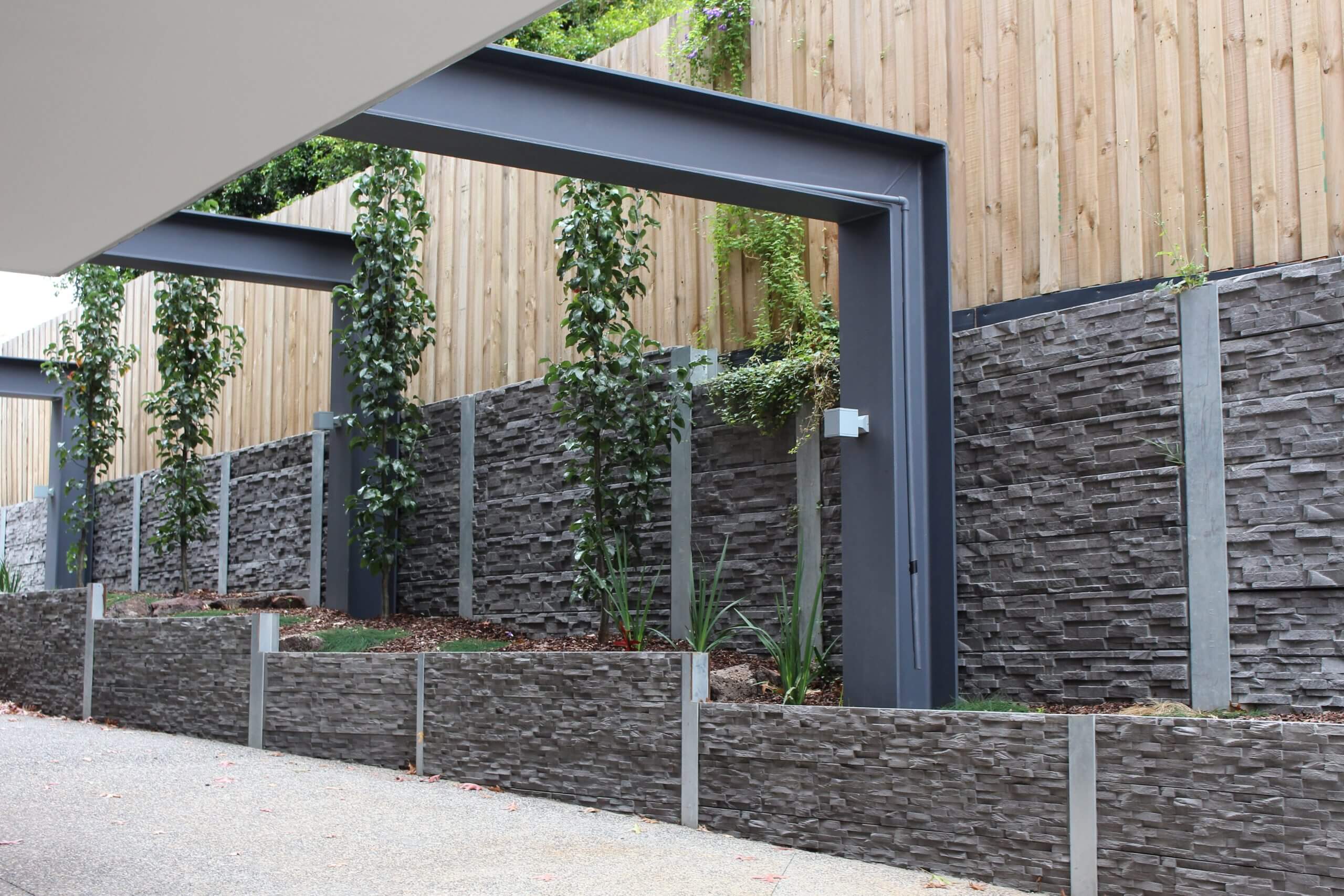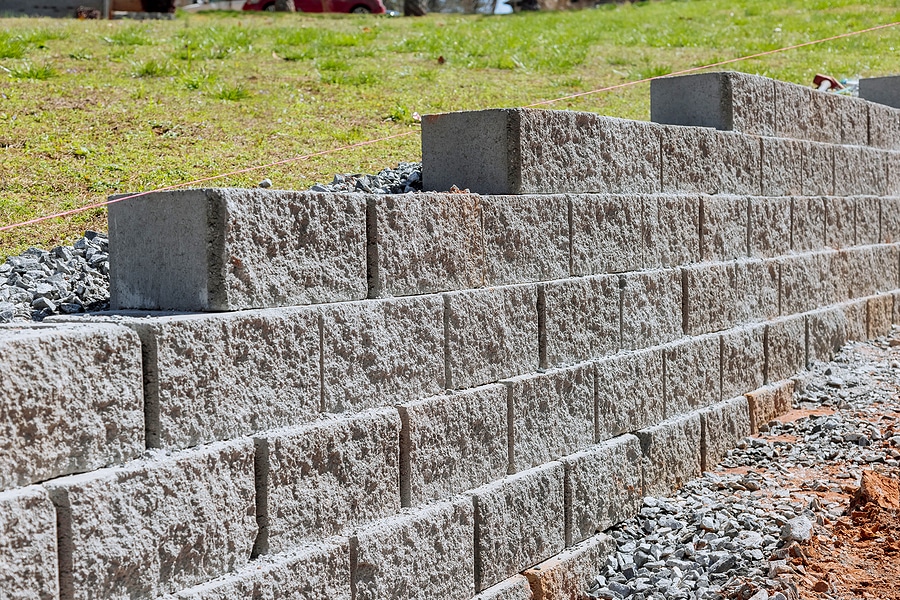How OKC Precision Retaining Walls benefit structural developments
Wiki Article
Trick Considerations for Building Efficient Retaining Walls in Your Lawn
When you're thinking about building a keeping wall surface in your backyard, it's crucial to think concerning numerous vital variables. The wall surface's objective, the materials you'll use, and the certain soil problems can all affect its performance and long life.Recognizing the Purpose of Your Retaining Wall
When you consider building a maintaining wall, consider its major purpose: stabilizing soil and protecting against erosion. Retaining walls give vital assistance for sloped landscapes, helping to maintain soil stability. You'll discover they're important in areas where water drainage may otherwise get rid of soil, bring about pricey repairs and landscape damages.By holding back planet, these walls create level surface areas for gardens, patio areas, or pathways. This not just enhances your backyard's looks yet also promotes far better drainage, decreasing water pooling in undesirable areas. If you're managing high inclines, a well-constructed retaining wall surface can protect against landslides, guaranteeing security for you and your building.
Ultimately, recognizing the purpose of your retaining wall surface will certainly guide your style decisions and assist you create a useful, sturdy structure that fulfills your requirements. So, take a minute to evaluate your landscape; it'll settle in the future.
Selecting the Right Products
When selecting products for your retaining wall, you'll wish to take right into account toughness, aesthetics, and expense. Each variable plays an essential function in guaranteeing your wall surface stands the test of time while looking terrific and suitable your budget plan. Allow's discover just how to make the best options for your task.Product Resilience Variables
Choosing the appropriate products is essential for the long life and effectiveness of your retaining wall surface, because their durability straight influences the wall surface's ability to endure ecological stresses. Begin by considering your neighborhood environment; materials like concrete and rock resist moisture and temperature level changes well. If you live in an area prone to hefty rainfalls, choose materials with good water drainage buildings, like gravel or permeable blocks, to avoid water accumulation.Some materials execute better in specific dirt kinds, so it's important to match them as necessary. Choosing durable products assurances your retaining wall surface stands strong, securing your lawn for years to come.
Visual Layout Choices
Sturdy products not just ensure your retaining wall's structural honesty yet likewise play a vital duty in its aesthetic appeal. When selecting the best products, believe concerning exactly how they complement your landscape. Natural rock offers a classic, rustic look, while concrete blocks can give a streamlined, modern finish. You might likewise think about utilizing hardwood for a warm, organic feeling. Shade and structure matter, as well; choose shades that harmonize with your home and garden. Don't forget the wall surface's form-- curved walls can create a softer appearance, while straight lines can feel much more organized. By thoroughly picking products that align with your visual vision, you'll improve your exterior area while ensuring your wall surface stands solid against the elements.Cost-Effectiveness Evaluation
Choosing the appropriate materials for your retaining wall isn't simply about aesthetic appeals; it's also important for your budget. When selecting materials, think about both upfront expenses and lasting resilience.Don't fail to remember to aspect in upkeep prices also (OKC Precision Retaining Walls). Some products, like natural stone, can add charm and need less upkeep, while others might require normal treatments
Inevitably, weigh the advantages and disadvantages of each alternative against your budget plan and the wall surface's desired purpose. Spending sensibly in materials now can protect against pricey issues later on. Select products that balance price and efficiency properly.
Assessing Dirt Problems and Drain
As you begin your job, reviewing soil conditions and drainage is crucial for the success of your retaining wall. Start by taking a look at the kind of soil in your backyard. Sandy dirt drains well however does not have stability, while clay dirt can keep moisture, bring about press on your wall surface. Check the dirt's wetness content by digging a little hole and observing how rapidly it dries.Following, analyze the incline of your backyard. If water normally streams toward your wall surface, you'll need to execute a drain remedy to stop disintegration and stress build-up. Think about installing perforated pipes or crushed rock backfill behind the wall surface to facilitate water drainage.
Last but not least, observe any neighboring trees or plants; their roots can impact dirt security. By recognizing your dirt conditions and carrying out proper water drainage, you'll produce a strong foundation for your retaining wall surface that stands the test of time.
Following Local Structure Codes
Before you begin developing your retaining wall surface, you need to research study local laws to ensure compliance. It's vital to comprehend what allows you should obtain, as this can save you from expensive fines or needing to remodel your job. Taking these steps seriously will help you develop a safe and effective structure.Study Local Regulations
Comprehending local regulations is essential when intending your retaining wall task, specifically because constructing codes can differ considerably by place. Start by talking to your regional building division or community to discover particular demands. Search for guidelines on wall elevation, products, water drainage systems, and architectural integrity. Numerous locations have constraints on the sorts of materials you can utilize and just how high you can build. You'll likewise wish to take into consideration the zoning laws that might impact your job. Ignoring these regulations can lead to expensive fines or the requirement to renovate your job. By doing your research upfront, you can ensure your retaining wall meets all essential codes and blends effortlessly into your backyard.
Get Needed Permits
Once you've researched local policies, you could try this out the following step is to get the required useful reference licenses for your retaining wall surface project. They may require details strategies or engineering assessments, especially for larger walls. Securing the right approvals can conserve you from expensive penalties or having to dismantle your wall later.
Planning the Layout and Aesthetics
As you begin intending the design and aesthetics of your retaining wall surface, take into consideration just how it will integrate with the bordering landscape. Consider the materials you'll make use of-- stone, brick, or concrete-- and how they'll match your home's architecture and the natural components in your yard. Select shades and appearances that mix seamlessly with existing functions like outdoor patios, pathways, or gardens.Following, imagine the wall surface's shape and elevation. Curved walls can soften an inflexible landscape, while straight lines may communicate an extra modern-day look. Do not fail to remember to incorporate plants and greenery around the wall for an all-natural touch; this can improve its charm and integrate it right into the environment.
Last but not least, remember performance. Your layout ought to not just be aesthetically pleasing yet also offer its purpose efficiently. By attentively planning these aspects, you'll produce a maintaining wall that boosts your yard's elegance while meeting its structural function.
Determining Elevation and Thickness Needs
To develop a durable retaining wall, you require to properly compute its height read the article and density needs based upon the dirt conditions and the elevation of the incline it will certainly support. Beginning by evaluating the slope's angle and the sort of soil, as different dirts put in varying quantities of stress.For walls over 4 feet high, consider a density of a minimum of 12 inches. If the wall is taller, raise the density proportionally to keep stability.
Following, calculate the elevation of the wall by determining the upright range it needs to retain. For every single foot of height, you ought to typically intend for a density of one-third of the wall's elevation.
Always keep in mind to account for additional variables like water drainage and backfill, which can influence your wall surface's layout. Proper calculations currently ensure your retaining wall stands strong and lasts for years to find.
Maintenance and Longevity Considerations
While keeping your retaining wall might feel like a reduced priority, ignoring it can result in considerable problems over time. Routine evaluations are crucial; look for splits, protrudes, or any indications of water damage. Addressing these issues early can save you from pricey repairs down the road.Watch on drainage systems, too. Obstructed drains pipes can trigger water to develop, putting in pressure on your wall surface and compromising its stability. Clear debris and warranty correct circulation to keep longevity.
You might also want to reflect on securing your wall surface to safeguard it from dampness and weathering. Relying on the material, this may require reapplication every few years.
Last but not least, landscaping around your wall surface can sustain its honesty. Stay clear of growing large trees nearby, as their origins can undermine the foundation. With proactive upkeep, your retaining wall can offer you well for several years ahead.

Regularly Asked Concerns
Can I Develop a Retaining Wall by Myself, or Should I Hire an Expert?
You can most definitely build a preserving wall surface on your own if you have the right tools and understanding. Nevertheless, working with an expert warranties it's done correctly, particularly for bigger or even more complicated frameworks. Consider your ability level prior to choosing.What Are the Most Common Blunders Made When Building Retaining Walls?
When developing retaining walls, you could forget proper water drainage, avoid making use of the ideal products, or neglect support. These common mistakes can cause structural failure, so take your time and strategy very carefully to stay clear of concerns.Just how Do I Know if My Retaining Wall Needs Reinforcement?
You'll know your retaining wall needs support if you notice cracks, leaning, or protruding. Inspect for water pooling behind it or dirt erosion near the base. Address these indicators immediately to stop further damage.What Plant kingdom Appropriate for Landscaping Around a Retaining Wall?
When landscape design around a keeping wall surface, take into consideration using low-maintenance plants like succulents, ornamental lawns, or slipping ground covers - OKC Precision Retaining Walls. They'll thrive in those conditions and include appeal while avoiding soil erosion around your wall surfaceJust How Can I Avoid Erosion Around My Retaining Wall?
To avoid disintegration around your retaining wall, you can grow ground cover, use mulch, and install drainage systems. Consistently look for water accumulation and adjust landscape design to redirect drainage away from the wall.Report this wiki page